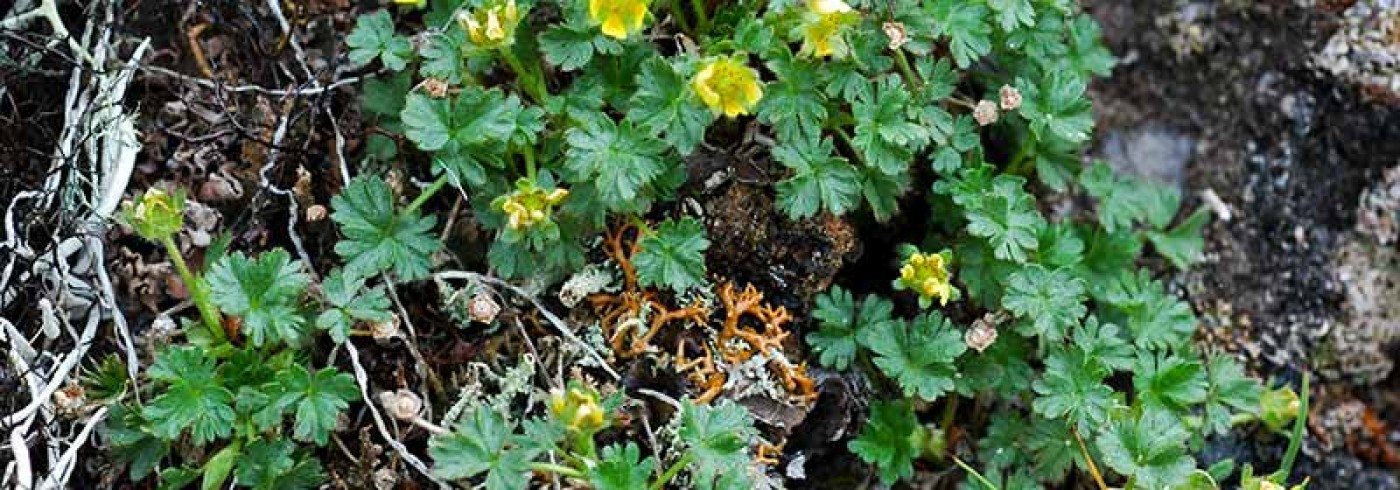Genetic diversity, evolution, and taxonomy in Potentilla, a problematic Arctic genus
Most plant species in the Arctic pose no immediate problem for the taxonomist. They are easy to determine and well-delimited from their nearest relatives. The opposite situation is, however, also met with. In a number of Arctic genera the boundaries between species are blurred. But why? Often we find the problems among plants with high chromosome numbers that self-pollinate, hybridize with other species, or rely heavily on vegetative reproduction. All these features have impact on the genetic variation of the plants. They are processes that add to the genetic variability, or structure the variation in certain ways. It is, in turn, the genetic diversity within species that allows them to evolve in changing environments under varying selection pressures. In the past, botanists have had to rely on the morphology of the plants for classification, i.e., they have compared the size and shape of leaves, flowers, etc. It has turned out that morphological data alone cannot solve the taxonomical problems in these difficult groups. Today, we have molecular tools that help us decide which morphological characters carry systematic information and how the complexes can be subdivided into recognizable entities. It has become increasingly important over the last decade to be able to identify species because species is the basic unit for discussing biodiversity and conservation. As long as we do not know the number of species there is in a given area, we cannot assess the area’s species diversity and value.
The research plan for this project involves studies on the genetic and taxonomic diversity of the wide-spread, but notoriously difficult, Arctic species of Cinquefoils (Potentilla). An important aim of the study is to provide a modern treatment for the pan-Arctic flora (within CAFF, Conservation of Arctic flora and fauna).
The studies on individual plant taxa form part of the Biodiversity sub-theme Genetic diversity, and the aim is to compare genetic diversity in organisms along latitudinal and longitudinal gradients. The organisms under study range from small soil-dwelling spring tails and lemmings among the animals, through mosses and lichens to vascular plants. The questions we would like to answer are:
- Whether a high genetic diversity in one organism implies that all other organisms at the same site are also genetically diverse (due to the fact that the area has a common history), or if the organisms are different with respect to genetic diversity (due to phylogeny, speed of evolution, different migration histories).
- Whether a high species diversity within a group is coupled with an equally high genetic diversity of the organisms involved.
Field and laboratory work
At each site 3–5 individuals from each of one or more populations of each species were collected. From every individual the following material was sampled:
- Herbarium specimen (voucher).
- Leaves (pressed and dried for morphometric measurements).
- Silica-dried leaves (for DNA extraction).
- Flowers and leaves (liquid collection for morphological studies).
- Shoots for transplantation (living material for chromosome studies).
In addition, general herbarium collections of flowering plants for the pan-Arctic flora project were carried out.
Preliminary results
The total number of plants collected leg 1 was 429.
The total number of Potentilla species was 6–8 depending on the taxonomy adopted. The total number of Potentilla collected amounted to 29 on leg 1, 14 on leg 2 (collected by U. Molau and R. Elven).
Three main groups of Potentilla sect. Niveae (subg. Hypargyrium) are represented in the collections: P nivea, P uniflora, and P. hookeriana. Within these main groups the taxa P. vahliana and P. rubricaulis are sometimes recognized. Furthermore, P. pulchella from sect. Multifida (subg. Hypargyrium), P. hyparctica from sect. Aureae (subg. Dynamidium), and P. fruticosa (Pentaphylloides fruticosa) were found. The P. uniflora complex is represented by a long array of different forms. Some plants are strongly cushion-shaped and have tiny, trifoliate leaves. Others consist of loose rosettes with coarse and pentafoliate leaves. The variation found demonstrates the essence of the basic problem regarding interpretation, or translation, of morphological variation in to genetic variation and taxonomy. At the same time, the variation in the material collected offers an opportunity to test hypotheses about relationships among the different forms and species groups.
Dates
June–September 1999
Participants
Principal investigator
Bente Eriksen
Department of Botany, University of Gothenburg
Sweden

